Repeaters or "talking" watches
 According to the history, the first mechanical clocks had been created in Tang China in 725 AD, long before man learned to use the electric light. Let's imagine for a moment that we are miraculously transported from the XXI century, for example, for four centuries ago. Suppose you wanted to know what time it was, but, unfortunately, there was dark night outside. Try to find a switch in the dark is useless, because there wasn’t any. If we compare the present situation with the past, we can say that in the XVII century people lived in complete darkness. After all, they didn’t have even a street lighting, not to mention electric. And such phenomenon, as luminescence, was actively talked much later. Coated with radium luminous hands on the clocks appeared only in 1914. So, to know the time you will need to wait until a sleepy servant bring a lighted candle, which, among other things, strives to go out at the slightest breath of wind or a draft. In addition, lighting a candle at that time was not easy, because they didn’t have such "modern miracle" like matches. Before the invention of matches by von Shrotter in 1845, people obtained fire by kicking silicon on a piece of steel. And finally, you look at a weekly lighted dial of your time meter, dreaming about how to get rid of this job only to find out the time. I would venture to suggest that mankind owes such an amazing invention, as repeater in watches, to the darkness. Maybe, I exaggerate the value of darkness in the history of repeaters. After all, according to some sources, originally the repeater was designed specifically for sailors, who had difficulties in obtaining a fire to determine the time. However, as a rule, pocket or wrist watches with repeater had a relatively low water resistance, since the complete sealing of the case made the sound of repeater muted and quiet. So, in 1680 the problem of night identification of time was brilliantly solved, and the mechanical watches acquired a "right to vote". First, only the wall mechanical clocks could "talk", and later the pocket watches got such ability, and then the wristwatches. Before delving into the description of repeaters, it should be noted that the mechanical clocks with repeaters differ from the striking clocks, although the repeater and the chime can easily coexist in one case. Thus, the striking clocks (for example, well-known chimes) strike the current time at regular intervals (every hour or half hour), even if no one is interested in the time at the moment, while the repeater informs the current time to the owner at his request by pressing a button. Moreover, such watches can inform the time more than once, as often as you like, or as long as the winding allow. According to the history, the first mechanical clocks had been created in Tang China in 725 AD, long before man learned to use the electric light. Let's imagine for a moment that we are miraculously transported from the XXI century, for example, for four centuries ago. Suppose you wanted to know what time it was, but, unfortunately, there was dark night outside. Try to find a switch in the dark is useless, because there wasn’t any. If we compare the present situation with the past, we can say that in the XVII century people lived in complete darkness. After all, they didn’t have even a street lighting, not to mention electric. And such phenomenon, as luminescence, was actively talked much later. Coated with radium luminous hands on the clocks appeared only in 1914. So, to know the time you will need to wait until a sleepy servant bring a lighted candle, which, among other things, strives to go out at the slightest breath of wind or a draft. In addition, lighting a candle at that time was not easy, because they didn’t have such "modern miracle" like matches. Before the invention of matches by von Shrotter in 1845, people obtained fire by kicking silicon on a piece of steel. And finally, you look at a weekly lighted dial of your time meter, dreaming about how to get rid of this job only to find out the time. I would venture to suggest that mankind owes such an amazing invention, as repeater in watches, to the darkness. Maybe, I exaggerate the value of darkness in the history of repeaters. After all, according to some sources, originally the repeater was designed specifically for sailors, who had difficulties in obtaining a fire to determine the time. However, as a rule, pocket or wrist watches with repeater had a relatively low water resistance, since the complete sealing of the case made the sound of repeater muted and quiet. So, in 1680 the problem of night identification of time was brilliantly solved, and the mechanical watches acquired a "right to vote". First, only the wall mechanical clocks could "talk", and later the pocket watches got such ability, and then the wristwatches. Before delving into the description of repeaters, it should be noted that the mechanical clocks with repeaters differ from the striking clocks, although the repeater and the chime can easily coexist in one case. Thus, the striking clocks (for example, well-known chimes) strike the current time at regular intervals (every hour or half hour), even if no one is interested in the time at the moment, while the repeater informs the current time to the owner at his request by pressing a button. Moreover, such watches can inform the time more than once, as often as you like, or as long as the winding allow.
First notes of repeater’s "song"
Before appearance of repeaters in watchmaking the masters made many attempts to make clocks "visible" in the dark. For example, in portable clock, designed in Germany in 1530, they applied special bumps opposite to every hour, so the time could be identified by touch. However, when they started to cover the clock dial with glass in the first half of the XVII century, those "bulges" turned to be useless. And then, eureka! The watchmakers had a brain-wave! They created the first clock, which became a kind of "companion", it said the time when they asked it (the striking clocks, already existed at the time, faded into the background). the masters made many attempts to make clocks "visible" in the dark. For example, in portable clock, designed in Germany in 1530, they applied special bumps opposite to every hour, so the time could be identified by touch. However, when they started to cover the clock dial with glass in the first half of the XVII century, those "bulges" turned to be useless. And then, eureka! The watchmakers had a brain-wave! They created the first clock, which became a kind of "companion", it said the time when they asked it (the striking clocks, already existed at the time, faded into the background).
Now let's look at a brief chronological table to structure our knowledge about the history of repeaters:
1679 - Edward Booth (Barlow) invented the first movement, able to strike the hours. However, it was a bulky desktop clock, which, of course, couldn’t be put in a pocket.
1686 - Englishman Daniel Quare created the first miniature clock with repeater, and in March 2, 1687, he was awarded a patent for the invention of quarters’ repeater. Let’s say that such clock was still quite thick.
1740 - thanks to Julian Le Roy, who replaced the bulky bell by the metal bar, and the repeater noticeably "lost its weight". Because of its muted sound, that kind of repeater was called "dumb repeater” or “montre a toc”.
1750 – watchmaker Thomas Mudge, also known as the creator of the escapement, most common today, designed the first minute repeater, able to strike hours, quarters and minutes. You probably will not be surprised if I add that Abraham Louis Breguet, "a jack of all trades", one of the merits of whom is also the reduction of repeater’s size, was actively involved in the improvements of that movement. Breguet replaced the bell by gongs, metal complex-shaped pins, fastened on one side. Now to change the key, the gongs are made of different lengths.
1796 - Antoine Favre created a miniature musical clock, in which he used a comb with teeth of different length, and correspondingly, of different keys.
The further evolution of repeaters had a technical nature.
Unique voices of repeaters
It would seem, to press the button on the case and find out the time, what could be easier! But the repeaters in mechanical watches are not as simple as they seem. There are several types of "speaking" and "singing" mechanism. Typically, the repeater can sing by two voices, i.e. to reproduce the sounds of two tones - high and low. Its couple of gongs-hammer, invented by incomparable Breguet, is responsible for each of the tones. The wristwatches with repeater can report the time to the nearest minute, depending on the type of "singing" mechanism. out the time, what could be easier! But the repeaters in mechanical watches are not as simple as they seem. There are several types of "speaking" and "singing" mechanism. Typically, the repeater can sing by two voices, i.e. to reproduce the sounds of two tones - high and low. Its couple of gongs-hammer, invented by incomparable Breguet, is responsible for each of the tones. The wristwatches with repeater can report the time to the nearest minute, depending on the type of "singing" mechanism.
Let's start with a quarter-repeater. It strikes full hour with a low-tone strokes, and the number of quarters that have elapsed in the next hour – with a high tone. For example, it is 11:36 now. By clicking on the button, you will hear 11 low strokes and 2 high strokes (two quarters).
Another type of repeater - a five-minute, striking five-minute intervals by high tone, but the quarters are struck by double strike of hammers. For example, 11:36 would sound as follows - 11 low strokes, two doubled and one high. However, you might found simpler five-minute repeaters more often, in which at first 11 low strokes and 7 high strokes will sound (i.e. seven five-minute intervals).
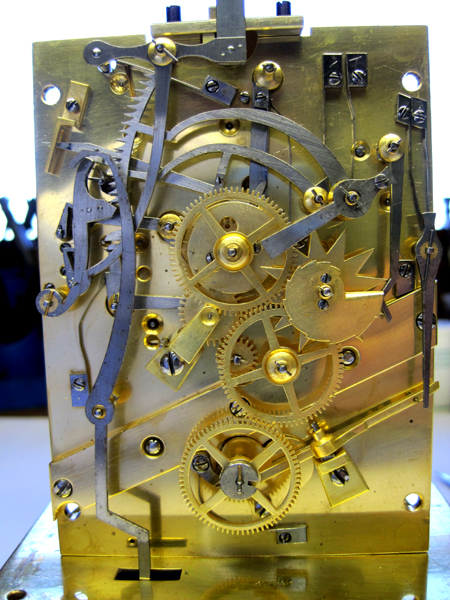 The most accurate repeaters are minute ones, in which the high tone informs minutes. Once again, imagine 11:36, press the button and listen. Again 11 low strokes, 2 double and 6 high signals. Also, there are minute repeaters, in which the dual signal corresponds to five-minute intervals, not quarters. The most accurate repeaters are minute ones, in which the high tone informs minutes. Once again, imagine 11:36, press the button and listen. Again 11 low strokes, 2 double and 6 high signals. Also, there are minute repeaters, in which the dual signal corresponds to five-minute intervals, not quarters.
And now attention, please! There is also a quite rare half-quarter repeater, which can easily confuse not only the beginner. Such half-quarter repeater strikes intervals of seven and a half minutes by high tone. To see what your repeater wants to "say", it is necessary to focus on.
In any case, only once you’ve tried to determine the time by yourself and compared it with a visual indications, you will not be able to break away from the magical sounds of gongs and hammers. You don’t have to a great mathematician to learn to count the time using the repeater. It also won’t be difficult to correctly calculate the number of tones of different keys.
The expensive, complex and unique repeaters, such as “Grand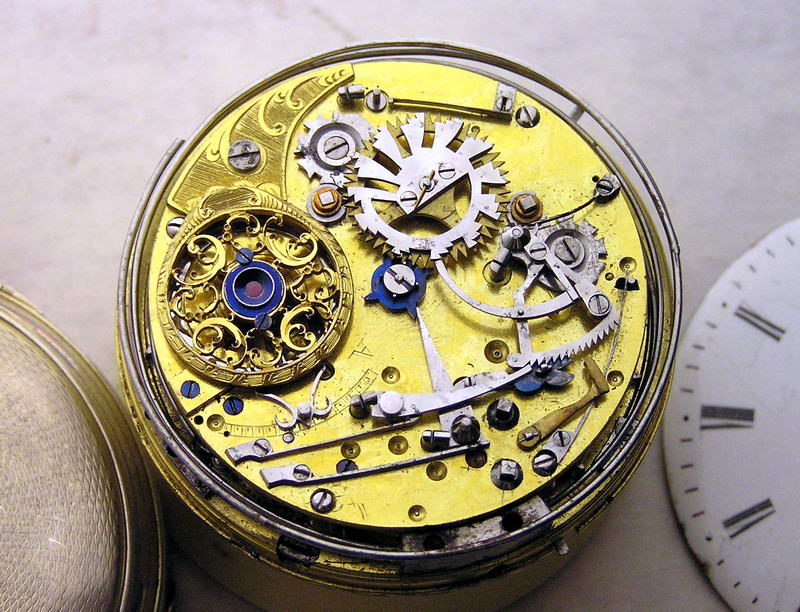 Sonnerie”, “Petite Sonnerie” and “Carillon”, deserve special attention. Grand Sonnerie, in addition to repetitions, automatically strikes full hours and quarters, and Petite Sonnerie strikes the number of hours, as you’ve guessed, it "sings" twenty four times a day. But if you do not want to listen to this song around the clock, you can stop it by blocking the sound mechanism with a special clamp. The most interesting watches from all the above mentioned is the watch, equipped with a device called “Carillon”. In this watch three and more gongs and bells are used, which allow the watch to strike every single quarter by separate tone. Thus, the most famous wristwatch “Star Caliber 2000” with carillon was released by the Swiss watchmaker “Patek Philippe”. This watch is provided with five discordant gongs, striking the bells’ sound of Big Ben in London (Westminster Abbey). Sonnerie”, “Petite Sonnerie” and “Carillon”, deserve special attention. Grand Sonnerie, in addition to repetitions, automatically strikes full hours and quarters, and Petite Sonnerie strikes the number of hours, as you’ve guessed, it "sings" twenty four times a day. But if you do not want to listen to this song around the clock, you can stop it by blocking the sound mechanism with a special clamp. The most interesting watches from all the above mentioned is the watch, equipped with a device called “Carillon”. In this watch three and more gongs and bells are used, which allow the watch to strike every single quarter by separate tone. Thus, the most famous wristwatch “Star Caliber 2000” with carillon was released by the Swiss watchmaker “Patek Philippe”. This watch is provided with five discordant gongs, striking the bells’ sound of Big Ben in London (Westminster Abbey).
It should be also noted that there is another interesting kind of repeaters called "jacquemart". On the dial of such watches, small figures "live", moving in time with the gong’s strikes, creating the impression that this is the sound they produce. To date, the most famous Swiss watches with jacquemarts are watches of the famous company- "puppeteer” Ulysse Nardin.
Do we need a repeater today?
We can say without exaggeration that the creation of repeaters became a separate big chapter in the great book of watchmaking. Tower, desktop clocks, pocket, and then wrist watches with repeaters and chime won the hearts of many famous people. The watch fan Peter I, fallen in love with "talking" clocks in Netherlands, had a very interesting clock with chime. The chimes of the emperor were equipped with glass bells, and were driven by water. Affected by delightful spectacle of the clock, the Peter's contemporaries called that water chimes a "bell tower that goes by water". The great composers Peter Tchaikovsky and Richard Wagner, whose authoritative opinions on the issue of music, no doubt, were of great importance, also liked musical clocks. Sir Winston Churchill did not part with his old repeater for a minute, which he got from his grandfather.
However, it should be noted that the repeaters didn’t bask in fame for a long time, as in 1840s safety matches were introduced, allowing easier "extraction" of fire. Then, the kerosene and gas lamps, which gradually pushed the repeater to the background, were invented. And the electric lamps and luminescence are nothing to speak of. However, the repeaters tried to regain at least a piece of past glory, and the watchmakers produced such luxury "talking" clocks in small lots.
Today things are different. It is believed that the watch company that created the repeater is a company that deserves great respect. The modern watchmakers rightly believe that making repeaters is prestigious. The first men's wristwatch with minute repeater was created by the masters of the Swiss company “Audemars Piguet” in 1892. Thus, Audemars Piguet is one of the major manufacturers of such "vociferous" mechanical watches. Along with great Audemars Piguet, such Swiss watch companies, as Vacheron Constantin, Patek Philippe, Blancpain, Ulysse Nardin, Kelek and some others, are engaged in making repeaters. You may have noticed that among the masters of repeaters only the 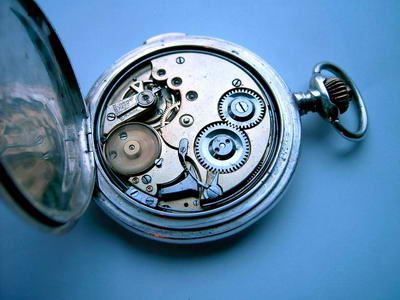 companies with world-wide reputation showed up – this confirms the fact that the production of repeater is an incredibly difficult and laborious process. If we take into account the fact that the repeater is a complex mechanism, which is, in some sense, a useless device in the modern world and which, besides, not everyone can afford, as it costs fabulous money, then a logical question arises: why do the watch giants still continue to produce repeaters, and the most sophisticated connoisseurs of horology and collectors continue to buy them? There are reasons for sure! First of all, the repeater is a mechanical marvel, created by human hands, it's part of culture, a piece of history. The repeaters have an aura of antiquity and mystery, "the voice" of repeater charms, bewitches and envelops with a light veil of magic. I would venture to suggest that the second reason why the wristwatches with repeaters still continue to "call their owners for lunch" is an opportunity for the watch companies to demonstrate all facets of their amazing craftsmanship, and for the owner of repeater - an opportunity to highlight not only his financial, but also high cultural level. Returning to the question "whether we need repeater today?", we must say "yes, we need!". The modern horlogerie has reached an incredible progress and the highest level; the most unusual watches of complicated designs and colors, decorated with precious stones, are created; and what an amazing device the tourbillon is, which is improving every year. But sadly, due to some tragic reasons, the external beauty of watches can’t be appreciated by everybody, the diamonds are essentially just stones, beautiful though, but the sounds and music are something magical that touches all the strings of our soul and stays forever in heart. The wristwatches with repeaters are watches that talk to you, that sing their endless song of time; they are your friends, assistants, companions. They are live watches, which have their delicate, polyphonic soul. companies with world-wide reputation showed up – this confirms the fact that the production of repeater is an incredibly difficult and laborious process. If we take into account the fact that the repeater is a complex mechanism, which is, in some sense, a useless device in the modern world and which, besides, not everyone can afford, as it costs fabulous money, then a logical question arises: why do the watch giants still continue to produce repeaters, and the most sophisticated connoisseurs of horology and collectors continue to buy them? There are reasons for sure! First of all, the repeater is a mechanical marvel, created by human hands, it's part of culture, a piece of history. The repeaters have an aura of antiquity and mystery, "the voice" of repeater charms, bewitches and envelops with a light veil of magic. I would venture to suggest that the second reason why the wristwatches with repeaters still continue to "call their owners for lunch" is an opportunity for the watch companies to demonstrate all facets of their amazing craftsmanship, and for the owner of repeater - an opportunity to highlight not only his financial, but also high cultural level. Returning to the question "whether we need repeater today?", we must say "yes, we need!". The modern horlogerie has reached an incredible progress and the highest level; the most unusual watches of complicated designs and colors, decorated with precious stones, are created; and what an amazing device the tourbillon is, which is improving every year. But sadly, due to some tragic reasons, the external beauty of watches can’t be appreciated by everybody, the diamonds are essentially just stones, beautiful though, but the sounds and music are something magical that touches all the strings of our soul and stays forever in heart. The wristwatches with repeaters are watches that talk to you, that sing their endless song of time; they are your friends, assistants, companions. They are live watches, which have their delicate, polyphonic soul.
Men's watch from Jaeger LeCoultre “Hybris Mechanica Grande Sonnerie”
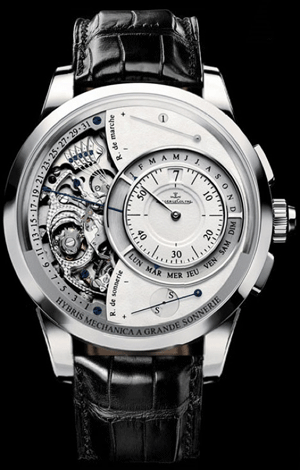 It is known that the major modern It is known that the major modern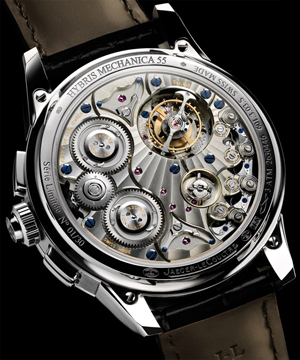 complications are ubiquitous tourbillon, perpetual calendar and, of course, incomparable repeater. If the watch contains at least one of these complications, then you can safely applaud the talent and skills of the watchmakers, created such a masterpiece. But that's not the end of Horology - the famous Swiss watch company Jaeger LeCoultre broke all known records by the number of complications in a wristwatch in 2009. Thus, the men's watch from Jaeger LeCoultre “Hybris Mechanica Grande Sonnerie” is composed of more than 1300 (!) parts and is able to perform 26 (!) different functions. It’s amazing how the watchmakers managed to place it all in a 44-millimeter watch case of 15 mm thickness. Speaking of the case, it is made of 18 carat white gold that also increases the value of this model. However, let's get closer to the point. The main complication we’re interested in at the moment is repeater, a part of the ancient history of watchmaking, a kind of "ringtone" in mechanical watches from different ages. The repeater of Jaeger LeCoultre is a new level of watchmaking, the latest complicated design in repetition field - this is repeater “Grande Sonnerie”. The mechanism of this repeater has received 13 patents, its feature is the “gearbox" of 5.15 mm height, created by the masters of Jaeger LeCoultre, distributing the energy of winding to rotating gears and hammers, creating music. This box solves the eternal problem of repeater - the problem of saving energy, when almost 60% of the spring force is spent on the sound. One of the most talented watchmakers - 30-year-old David Kando, who called his mechanism an "infernal tower", worked on the repeater. Kando has designed a special device of gongs, which support strong (at least 40-50 dB) and sustained sound. Typically, wrist watches are completely sealed to ensure water resistance, so the sound of repeater becomes muted. Also, the hammers, which are usually fixed toughly, weaken the sound and absorb about 70-90% of stroke. However, in this model Kando used a system of flexible gongs (trebuchet), which do not quench the energy, and increases the strength and duration of the sound of repeater. The repeater by Jaeger LeCoultre is equipped with four hammers (this is a daunting engineering idea, since three hammers are already a luxury) and imitate Westminster chime that is an indicator of high watchmaking craftsmanship. The fans of watch music can admire the work of the repeater, situated on the dial at "8:30", with their own eyes. A button, mounted in the crown, activates the repeater. Above and below the crown there are by two buttons, the upper-right of which adjusts the indicator "jumping hour", the upper-left is responsible for the regimes of minute repeater (Grande Sonnerie is a complete sound of melody with chime, Petit Sonnerie - a short melody, plus strike, and Silence - the melody and the strike are completely disabled). complications are ubiquitous tourbillon, perpetual calendar and, of course, incomparable repeater. If the watch contains at least one of these complications, then you can safely applaud the talent and skills of the watchmakers, created such a masterpiece. But that's not the end of Horology - the famous Swiss watch company Jaeger LeCoultre broke all known records by the number of complications in a wristwatch in 2009. Thus, the men's watch from Jaeger LeCoultre “Hybris Mechanica Grande Sonnerie” is composed of more than 1300 (!) parts and is able to perform 26 (!) different functions. It’s amazing how the watchmakers managed to place it all in a 44-millimeter watch case of 15 mm thickness. Speaking of the case, it is made of 18 carat white gold that also increases the value of this model. However, let's get closer to the point. The main complication we’re interested in at the moment is repeater, a part of the ancient history of watchmaking, a kind of "ringtone" in mechanical watches from different ages. The repeater of Jaeger LeCoultre is a new level of watchmaking, the latest complicated design in repetition field - this is repeater “Grande Sonnerie”. The mechanism of this repeater has received 13 patents, its feature is the “gearbox" of 5.15 mm height, created by the masters of Jaeger LeCoultre, distributing the energy of winding to rotating gears and hammers, creating music. This box solves the eternal problem of repeater - the problem of saving energy, when almost 60% of the spring force is spent on the sound. One of the most talented watchmakers - 30-year-old David Kando, who called his mechanism an "infernal tower", worked on the repeater. Kando has designed a special device of gongs, which support strong (at least 40-50 dB) and sustained sound. Typically, wrist watches are completely sealed to ensure water resistance, so the sound of repeater becomes muted. Also, the hammers, which are usually fixed toughly, weaken the sound and absorb about 70-90% of stroke. However, in this model Kando used a system of flexible gongs (trebuchet), which do not quench the energy, and increases the strength and duration of the sound of repeater. The repeater by Jaeger LeCoultre is equipped with four hammers (this is a daunting engineering idea, since three hammers are already a luxury) and imitate Westminster chime that is an indicator of high watchmaking craftsmanship. The fans of watch music can admire the work of the repeater, situated on the dial at "8:30", with their own eyes. A button, mounted in the crown, activates the repeater. Above and below the crown there are by two buttons, the upper-right of which adjusts the indicator "jumping hour", the upper-left is responsible for the regimes of minute repeater (Grande Sonnerie is a complete sound of melody with chime, Petit Sonnerie - a short melody, plus strike, and Silence - the melody and the strike are completely disabled).
Two lower buttons are adjusters of the minute hand. It should be noted that the buttons of the wristwatch are very sensitive, and a random press on the adjuster during the "song" of the repeater might lead to damage of the mechanism and, as a consequence, to expensive repairs. But the watchmakers “kept their end up", using an “idiot-proof" in their watches. In other words, this protection system blocks and disables the adjusters during the strike. Well, let’s take off our hats to the great talent and ingenuity of the watchmakers! But that's not all. A flying (unfixed) tourbillon, visible through transparent back case, completes all this beauty. The Swiss watch from Jaeger LeCoultre “Hybris Mechanica Grande Sonnerie” has tourbillon, the carriage of which is mounted on ceramic bearings (which do not require lubrication), and the balance-spring knot oscillates at the frequency of 28,800 vibrations per hour. I hope, our dear reader will appreciate another incredible movement by Jaeger LeCoultre at its true value, because you cannot ignore the last complication of the watch - perpetual calendar with a sector date indicator, leap year aperture (at "12:30") and weekday and month indicators, located along the minute scale. Now it's all about complexity. And a moment of attention, please! Such unique men's watches, as Jaeger LeCoultre Hybris Mechanica Grande Sonnerie, must be unique in every way. So if you want to purchase this Swiss watch, you’d better order its delivery. Although, if you're ready to go for it by truck, then do it, because the gift box of Jaeger LeCoultre Hybris Mechanica Grande Sonnerie is an armored safe of 1200 kg weight. Behind the door of the "box" three models of unique watches by Jaeger LeCoultre, one of which is described above, are stored. Two others are not less complex and original: Hybris Mechanica Triptyque and l `Hybris Mechanica Gyrotourbillon, which the buyer gets as a gift. We cannot but agree that the staff of Jaeger LeCoultre is very creative. I do not think there is a watch fan, who would not want to have such an incredible collection, consisting, perhaps, of the most complicated watches in the world. Well, there is hardly any left – just to take about 2.5 million dollars out of your wallet!
Men’s watch “Epos Oeuvre d’Art Repetition 5 Minutes” (Ref. 3373)
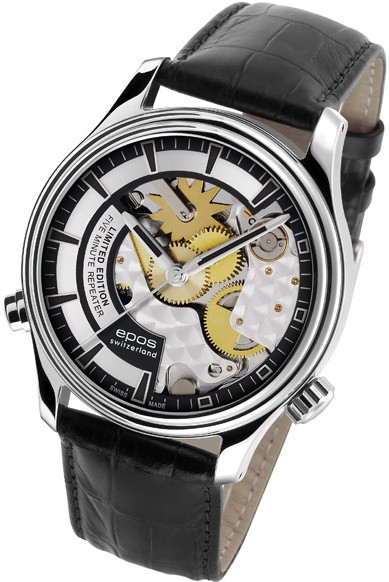 The watchmakers do not cease to surprise quite discerning modern audience by incredible novelties in the field of watches. Sure, many new and unique watch movements and devices are being created. However, the watchmakers do not forget to pay tribute to the ancient traditions of horlogerie, designing mechanisms with a unique repeater, which represents cultural value and the most complicated watch module. So far, it is believed that the creation of repeater is not for beginners. One of the main contenders for the title of "master of the best repeater" was the Swiss watch company “Epos”, which released a unique men's wristwatch with repeater “Epos Oeuvre d'Art Repetition 5 Minutes” for reference 3373 in 2009. The company Epos had already pleased its many fans with unique watches with complications, and that time it made a huge splash. The distinctive features of “Oeuvre d'Art Repetition 5 Minutes” are partially skeletonized dial and "music accompaniment", provided by a five-minute repeater. One cannot but pay tribute to the craftsmanship of the Swiss watchmakers, who didn’t only cut out a part of the dial, but artfully decorated bridges of the movement by "perlage", "Geneva stripes", and blued screws. All that, of course, was performed by hand. We remind our readers that all the most complicated watches from Epos are equipped with rare and unique movements based on the Unitas, A. Schild, Dubois Depraz. There is only one "but": these movements are delivered to the workshop, so to say, in disassembled form, as separate parts. Then the skilled hands of watchmakers finish and decorate all parts of the movements, and then assemble them. A striking example of such "movement-meccano" is ETA 2892-A2 with a five-minute repeater module 88DD. Thanks to partially skeletonized dial, only a part of the module, not the whole movement is seen to the watch owner. Thus, the watchmakers have given some mystery to their "talking" watch. Let's look at a "piece" of repeater through the sapphire crystal dial. An experienced connoisseur of watchmaking will see a part of repeater spring, minute snail with 11 teeth and minute transmission. The beginners in luxury watches will find gears of amazing beauty, rotating in a sequence known only to them. However, we will name all the details of the movement by their names, in order not to "offend" such a legendary and vintage watch complication, as repeater. One should pay particular attention to the location of control heads on the case of the wristwatch. The traditional lever, releasing the repeater spring, is replaced by a button, connected to the original lever, at "8" hours, which sets the pinion into motion. Such system (Bravo, Epos!) completely eliminates the possibility of failure of the movement, and one shouldn’t be afraid that the lever might, for example, go down incompletely, as it often happened with the old models of "speaking" watches. The fans of Epos will appreciate another "perk" from the Swiss company – this is an unusual location of the crown, which has "settled" at "4" hours, as if balancing the repeater button. You might think that such placement of the crown is just a meaningless whim of the watchmakers. I hasten to assure you that it is not. Such position provides a more convenient crown winding, and the watch does not have to be taken off from the wrist. One can easily make assure of it, trying to wind the Swiss watch “Epos Oeuvre d'Art” at least once. The ultra-accurate self-winding movement ETA 2892-A2 provides a power reserve of up to 42 hours though. And a little bit about other technical characteristics of the watch from Epos: the case - stainless steel, 42.5 mm in diameter and 12.9 in thickness, the transparent back case - from sapphire crystal, the water resistance - 50 meters. The functions, in addition to repeater: hours, minutes, seconds. The hands and indices are covered with luminescence for comfortable time reading in the dark. The black leather strap with classic stainless steel buckle completes the image of watch. The watchmakers do not cease to surprise quite discerning modern audience by incredible novelties in the field of watches. Sure, many new and unique watch movements and devices are being created. However, the watchmakers do not forget to pay tribute to the ancient traditions of horlogerie, designing mechanisms with a unique repeater, which represents cultural value and the most complicated watch module. So far, it is believed that the creation of repeater is not for beginners. One of the main contenders for the title of "master of the best repeater" was the Swiss watch company “Epos”, which released a unique men's wristwatch with repeater “Epos Oeuvre d'Art Repetition 5 Minutes” for reference 3373 in 2009. The company Epos had already pleased its many fans with unique watches with complications, and that time it made a huge splash. The distinctive features of “Oeuvre d'Art Repetition 5 Minutes” are partially skeletonized dial and "music accompaniment", provided by a five-minute repeater. One cannot but pay tribute to the craftsmanship of the Swiss watchmakers, who didn’t only cut out a part of the dial, but artfully decorated bridges of the movement by "perlage", "Geneva stripes", and blued screws. All that, of course, was performed by hand. We remind our readers that all the most complicated watches from Epos are equipped with rare and unique movements based on the Unitas, A. Schild, Dubois Depraz. There is only one "but": these movements are delivered to the workshop, so to say, in disassembled form, as separate parts. Then the skilled hands of watchmakers finish and decorate all parts of the movements, and then assemble them. A striking example of such "movement-meccano" is ETA 2892-A2 with a five-minute repeater module 88DD. Thanks to partially skeletonized dial, only a part of the module, not the whole movement is seen to the watch owner. Thus, the watchmakers have given some mystery to their "talking" watch. Let's look at a "piece" of repeater through the sapphire crystal dial. An experienced connoisseur of watchmaking will see a part of repeater spring, minute snail with 11 teeth and minute transmission. The beginners in luxury watches will find gears of amazing beauty, rotating in a sequence known only to them. However, we will name all the details of the movement by their names, in order not to "offend" such a legendary and vintage watch complication, as repeater. One should pay particular attention to the location of control heads on the case of the wristwatch. The traditional lever, releasing the repeater spring, is replaced by a button, connected to the original lever, at "8" hours, which sets the pinion into motion. Such system (Bravo, Epos!) completely eliminates the possibility of failure of the movement, and one shouldn’t be afraid that the lever might, for example, go down incompletely, as it often happened with the old models of "speaking" watches. The fans of Epos will appreciate another "perk" from the Swiss company – this is an unusual location of the crown, which has "settled" at "4" hours, as if balancing the repeater button. You might think that such placement of the crown is just a meaningless whim of the watchmakers. I hasten to assure you that it is not. Such position provides a more convenient crown winding, and the watch does not have to be taken off from the wrist. One can easily make assure of it, trying to wind the Swiss watch “Epos Oeuvre d'Art” at least once. The ultra-accurate self-winding movement ETA 2892-A2 provides a power reserve of up to 42 hours though. And a little bit about other technical characteristics of the watch from Epos: the case - stainless steel, 42.5 mm in diameter and 12.9 in thickness, the transparent back case - from sapphire crystal, the water resistance - 50 meters. The functions, in addition to repeater: hours, minutes, seconds. The hands and indices are covered with luminescence for comfortable time reading in the dark. The black leather strap with classic stainless steel buckle completes the image of watch.
Well, in conclusion, I hasten to add that the Swiss company “Epos” is gaining tremendous momentum – first, tourbillon (2008), and then, as a logical continuation of the first, repeater. By the way, only 200 music lovers will be able to listen to music of the watch “Epos Oeuvre d'Art”, since the series is strictly limited. If our dear reader is a fan of the enigmatic and mysterious music of repeater, the men’s watch “Epos Oeuvre d'Art Repetition 5 Minutes” will become a perfect example of song from a timeless repertoire of "singing" watches.
Men’s watch “Gerald Genta Arena Metasonic”
.jpg) Since we began our story of the greatest Since we began our story of the greatest.jpg) watches with repeaters, ever created by watchmakers, then we cannot pass by such legendary Swiss watch company, as Gerald Genta, which was founded by not less legendary man - Gerald Genta, who died in summer of 2011. The watch world, no doubt, has lost one of the most prominent watchmakers, who worked not only to create his own watches, but also collaborated with watch companies “Audemars Piguet”, “Patek Philippe”, “Vacheron Constantin”, “Omega”, etc. Let us honor the memory of great Gerald Genta, whose services for the watch industry are truly priceless, and turn our attention to the great watch “Gerald Genta Arena Metasonic”. watches with repeaters, ever created by watchmakers, then we cannot pass by such legendary Swiss watch company, as Gerald Genta, which was founded by not less legendary man - Gerald Genta, who died in summer of 2011. The watch world, no doubt, has lost one of the most prominent watchmakers, who worked not only to create his own watches, but also collaborated with watch companies “Audemars Piguet”, “Patek Philippe”, “Vacheron Constantin”, “Omega”, etc. Let us honor the memory of great Gerald Genta, whose services for the watch industry are truly priceless, and turn our attention to the great watch “Gerald Genta Arena Metasonic”.
The men's watch “Gerald Genta Arena Metasonic” is a watch with a bold character, causing the strongest emotions. I note that from 1994 the watch company has been producing watches with the mechanism of strike, which is also provided in this model. To avoid possible misunderstanding, I will explain that the big strike is one of the most complex mechanisms, which produces about 35,000 strokes a year. Such watches automatically strike hours and quarters, and have a function of minute repeater that produces Westminster strike. Each year, the company “Gerald Genta” improves its watches with repeaters, conducting the procedure of so-called normalization. Today I safely declare that the men’s watch “Gerald Genta Arena Metasonic” is the pinnacle of "repeater" craftsmanship of the watchmakers,.jpg) the peak of "singing" art. The normalization process consists in verifying and adjusting three parameters of the repeater module: intensity (strength) of notes in decibels, "correctness" of notes to get an identical height and cadence (regularity of playing) of notes. This complicated procedure does not eliminate the necessity for "manual" adjustments by watchmaker, performed at the final stage. Thus, every watch of Gerald Genta passes 10 consecutive stages, which require special attention and high craftsmanship of the watchmakers. the peak of "singing" art. The normalization process consists in verifying and adjusting three parameters of the repeater module: intensity (strength) of notes in decibels, "correctness" of notes to get an identical height and cadence (regularity of playing) of notes. This complicated procedure does not eliminate the necessity for "manual" adjustments by watchmaker, performed at the final stage. Thus, every watch of Gerald Genta passes 10 consecutive stages, which require special attention and high craftsmanship of the watchmakers.
To create the watch “Gerald Genta Arena Metasonic” in a special case, which will be discussed below, the specialists have designed a unique software that allows to analyze all materials. This system of test checks density, elasticity and materials wear coefficients, used in the manufacture of watches. Since the watch is equipped with minute repeater module, so the abovementioned parameters, in addition, must have a positive effect on the propagation and quality of sound. Taking into account all the parameters, the Swiss watch company has created a unique model of a clock “Arena Metasonic”: its middle part of the case is made of an ideal alloy “Magsonic ®”. The composition of patented alloy is kept in secret. It won’t be an exaggeration if I note that the Swiss watch “Gerald Genta Arena Metasonic” is an ideal watch with a minute repeater “Grande Sonnerie” in all respects. The middle part of the case for the watch with big strike has a crucial importance, as the sound spreads in the lateral plane, and the sound conduction of alloy Magsonic ® increases when the watch is worn on the wrist, when the back case is pressed on the hand. And one more "compliment" for the alloy - Magsonic ® surpasses other metals on the overall strength of sound and melody.
The watchmakers were not limited by a special alloy and created a unique, patented design of the watch case with a total diameter of 50 mm..jpg) The middle part of the case (from Magsonic ® alloy) is rimed and protected by back case, made of titanium grade 5, which are attached to the outside by special fastenings. As a result, none of the screws does not prevent the spread of the ideal sound. Contrary to popular belief that the sound "moves" better in untight watches, the watchmakers completely sealed the case of “Arena Metasonic” that did not affect the sound quality. Sleight of hand and no fraud! As for the design, the case is provided with vertical polished and horizontal dull surfaces. The men's watch “Gerald Genta Arena Metasonic” is offered with a black ostrich leather strap. The crown is engraved with individual number of each model, the number of which is limited by 10 pieces, and the opposite side of the case is provided with strike and repeater control buttons. The finishing of the movement, representing a wavy pattern and playing up the theme of sound wave, is clearly seen through the sapphire crystal and skeletonized dial of wrist watch. Of course, an experienced connoisseur of Horology will immediately detect a classic complication in this watch - the tourbillon that proved once again the uniqueness and complexity of "speaking" watch “Arena Metasonic” by Gerald Genta. The middle part of the case (from Magsonic ® alloy) is rimed and protected by back case, made of titanium grade 5, which are attached to the outside by special fastenings. As a result, none of the screws does not prevent the spread of the ideal sound. Contrary to popular belief that the sound "moves" better in untight watches, the watchmakers completely sealed the case of “Arena Metasonic” that did not affect the sound quality. Sleight of hand and no fraud! As for the design, the case is provided with vertical polished and horizontal dull surfaces. The men's watch “Gerald Genta Arena Metasonic” is offered with a black ostrich leather strap. The crown is engraved with individual number of each model, the number of which is limited by 10 pieces, and the opposite side of the case is provided with strike and repeater control buttons. The finishing of the movement, representing a wavy pattern and playing up the theme of sound wave, is clearly seen through the sapphire crystal and skeletonized dial of wrist watch. Of course, an experienced connoisseur of Horology will immediately detect a classic complication in this watch - the tourbillon that proved once again the uniqueness and complexity of "speaking" watch “Arena Metasonic” by Gerald Genta.
The laudatory ode to the unique wristwatch from Gerald Genta should be finished with a mention of exclusive protective glass box, in which the product is offered. In such box the watch remains invisible until the owner activates the biometric button, programmed directly for it. After pressing the button the light is flashed on inside the box, and the stand with the watch goes up. A unique “packaging” for a unique watch!
In conclusion I will not use a lot of beautiful epithets addressed to the watch “Gerald Genta Arena Metasonic”. It is useless, because everything is clear without words. We can only say: let great and unique Gerald Genta be remembered forever!
Men’s watch “IWC Portuguese Minute Repeater” (Ref. IW524101)
.jpg) The famous watch company “IWC” from Schaffhausen, the name of which is associated exclusively with high quality, uniqueness and exclusivity, has demonstrated once again all its greatness and power by creating a wonderful "singing" masterpiece. The men's watch “IWC Portuguese Minute Repeater” of reference IW524101 may be rightfully called one of the most beautiful skeleton watches with repeater in the world. First of all, let’s pay attention to the gorgeous dial, the domed sapphire crystal of which covers a breathtaking action. The "naked" dial shows the intricacies of hand-made parts of the skeletonized movement, the design of which took the watchmakers of IWC seven (!) years. The total number of elements of this unique "heart" makes up 230. The Swiss watch “IWC Portuguese Minute Repeater” was created on the base of great invention of the end of XVII century - the mechanism with repeater of caliber 1927, which first "gave life" to the pocket watches from IWC. The main feature of the manual winding caliber 9591, set in the case of IWC Portuguese Minute Repeater, is a unique minute repeater module, striking hours, quarters and minutes on request of its owner. The complicated movement from IWC works on 54 stones with a frequency of 18,000 vibrations per hour, providing a power reserve of up to 43 hours. Other functions of this time meter, in addition to repeater, are hours and minutes, displayed on the dial by two central thin blue steel hands. The skilled specialists of Swiss watch company made sure that the happy owner of the watch was able to enjoy the coordinated work of unique movement through an openwork dial, as well as through the sapphire crystal with anti-glare treatment of the watch-skeleton’s back case. The case of the IWC watch is made of 18 carat white gold, has a diameter of about 42 mm, and thickness of 12.3 mm. The elongated button, which puts the repeater into action, is traditionally situated at "9" hours, opposite to the crown. Despite the fact that the men's watch “IWC Portuguese Minute Repeater” contains the complication that is not so easy to put in a totally enclosed case, since, as a result, the sound of repeater becomes muted, the water resistance reaches 30 meters. The mechanical watch from IWC is equipped with a blue strap of high quality leather with a gold buckle. The men's watch “IWC Portuguese Minute Repeater” is available in another variant of reference IW524102 - in 18-carat pink gold case with brown leather strap and gold buckle. The issue of each rarest model is limited by only fifty copies. It only remains to add that the wristwatch with repeater still remains an indispensable assistant of person, who might get lost in time in the dark. Apart from the fact that the repeater is a kind of "time’s eye", its role of a "messenger from the past" and bearer of ancient horlogerie culture cannot but noted. The famous watch company “IWC” from Schaffhausen, the name of which is associated exclusively with high quality, uniqueness and exclusivity, has demonstrated once again all its greatness and power by creating a wonderful "singing" masterpiece. The men's watch “IWC Portuguese Minute Repeater” of reference IW524101 may be rightfully called one of the most beautiful skeleton watches with repeater in the world. First of all, let’s pay attention to the gorgeous dial, the domed sapphire crystal of which covers a breathtaking action. The "naked" dial shows the intricacies of hand-made parts of the skeletonized movement, the design of which took the watchmakers of IWC seven (!) years. The total number of elements of this unique "heart" makes up 230. The Swiss watch “IWC Portuguese Minute Repeater” was created on the base of great invention of the end of XVII century - the mechanism with repeater of caliber 1927, which first "gave life" to the pocket watches from IWC. The main feature of the manual winding caliber 9591, set in the case of IWC Portuguese Minute Repeater, is a unique minute repeater module, striking hours, quarters and minutes on request of its owner. The complicated movement from IWC works on 54 stones with a frequency of 18,000 vibrations per hour, providing a power reserve of up to 43 hours. Other functions of this time meter, in addition to repeater, are hours and minutes, displayed on the dial by two central thin blue steel hands. The skilled specialists of Swiss watch company made sure that the happy owner of the watch was able to enjoy the coordinated work of unique movement through an openwork dial, as well as through the sapphire crystal with anti-glare treatment of the watch-skeleton’s back case. The case of the IWC watch is made of 18 carat white gold, has a diameter of about 42 mm, and thickness of 12.3 mm. The elongated button, which puts the repeater into action, is traditionally situated at "9" hours, opposite to the crown. Despite the fact that the men's watch “IWC Portuguese Minute Repeater” contains the complication that is not so easy to put in a totally enclosed case, since, as a result, the sound of repeater becomes muted, the water resistance reaches 30 meters. The mechanical watch from IWC is equipped with a blue strap of high quality leather with a gold buckle. The men's watch “IWC Portuguese Minute Repeater” is available in another variant of reference IW524102 - in 18-carat pink gold case with brown leather strap and gold buckle. The issue of each rarest model is limited by only fifty copies. It only remains to add that the wristwatch with repeater still remains an indispensable assistant of person, who might get lost in time in the dark. Apart from the fact that the repeater is a kind of "time’s eye", its role of a "messenger from the past" and bearer of ancient horlogerie culture cannot but noted.
Men’s watch “Zenith Grande Class Traveller Repetition Minutes”
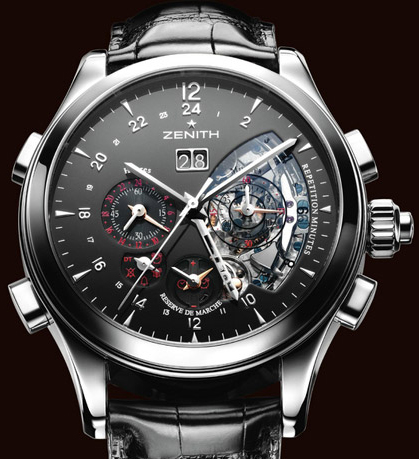 The Swiss watchmaker Zenith, The Swiss watchmaker Zenith,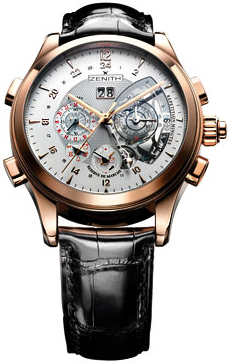 still pleasing its many fans by unique wristwatch models with various functions and complications, may safely boast of its skills and a good ear for music. The men's wristwatch “Grande Class Traveller Repetition Minutes” of Zenith is included in six most complicated watches in the world. And this title of champion is quite justified, because the wristwatch with a 44-millimeter case is able to perform as many as 46 functions. The complications that this masterpiece has are the most relevant and necessary in today's world, except maybe the tourbillon, which became sooner classic and traditional for the best models of watches, than unique. The Swiss watch “Zenith Grande Class Traveller Repetition Minutes” is lack of powerful tourbillon, but nevertheless able to determine the current time in another time zone, to note the time intervals up to 1/10 seconds (chronograph), equipped with automatic winding, an amazing triple power reserve indicator and unique calendar with big date, which is displayed in two apertures and changes at midnight, turning the wheels with Arabic numerals in a time interval of 0.006 seconds. I hope we have not forgotten anything! Well, of course, we can’t ignore the great sound of the watches from Zenith, which is equipped with minute repeater module, able to strike hours, quarters and minutes. The men's watch “Zenith Grande Class Traveller Repetition Minutes” will not allow its owner to miss a business meeting or forget about important conference, as it, in addition to chiming at the scheduled time (alarm function), also vibrates. This watch is certainly a useful accessory for busy people or for those, who like to take a nap for an hour or two. One of the main features of the minute repeater of Zenith Grande Class Traveller Repetition Minutes is the fact that the self-winding rotor is made of heavy 22-karat gold, decorated with a pattern “Cotes de Geneve”, rotates in two directions, thus fueling the drums of movement, alarm and minute repeater with the necessary energy simultaneously. The hard-working hammers beating on gongs at a request of their owner can be observed through the sapphire crystal and "cut" sector in the dial from the marking "1 hour" to "5 hours." A truly spectacular show, which you can admire endlessly, until your watch reminds you by its ring and vibration signal that "it is time to do business, rather than looking at hammers and gongs!". still pleasing its many fans by unique wristwatch models with various functions and complications, may safely boast of its skills and a good ear for music. The men's wristwatch “Grande Class Traveller Repetition Minutes” of Zenith is included in six most complicated watches in the world. And this title of champion is quite justified, because the wristwatch with a 44-millimeter case is able to perform as many as 46 functions. The complications that this masterpiece has are the most relevant and necessary in today's world, except maybe the tourbillon, which became sooner classic and traditional for the best models of watches, than unique. The Swiss watch “Zenith Grande Class Traveller Repetition Minutes” is lack of powerful tourbillon, but nevertheless able to determine the current time in another time zone, to note the time intervals up to 1/10 seconds (chronograph), equipped with automatic winding, an amazing triple power reserve indicator and unique calendar with big date, which is displayed in two apertures and changes at midnight, turning the wheels with Arabic numerals in a time interval of 0.006 seconds. I hope we have not forgotten anything! Well, of course, we can’t ignore the great sound of the watches from Zenith, which is equipped with minute repeater module, able to strike hours, quarters and minutes. The men's watch “Zenith Grande Class Traveller Repetition Minutes” will not allow its owner to miss a business meeting or forget about important conference, as it, in addition to chiming at the scheduled time (alarm function), also vibrates. This watch is certainly a useful accessory for busy people or for those, who like to take a nap for an hour or two. One of the main features of the minute repeater of Zenith Grande Class Traveller Repetition Minutes is the fact that the self-winding rotor is made of heavy 22-karat gold, decorated with a pattern “Cotes de Geneve”, rotates in two directions, thus fueling the drums of movement, alarm and minute repeater with the necessary energy simultaneously. The hard-working hammers beating on gongs at a request of their owner can be observed through the sapphire crystal and "cut" sector in the dial from the marking "1 hour" to "5 hours." A truly spectacular show, which you can admire endlessly, until your watch reminds you by its ring and vibration signal that "it is time to do business, rather than looking at hammers and gongs!".
I'm just kidding! Now about the serious thing: exploring the "internal organs" responsible for the life of the watch-assistant from the Zenith. This movement of 744 elements, working at 63 stones with a frequency of 36,000 vibrations per hour, is based at the firm's fastest caliber El Primero 4031. The power reserve is more than 50 hours.
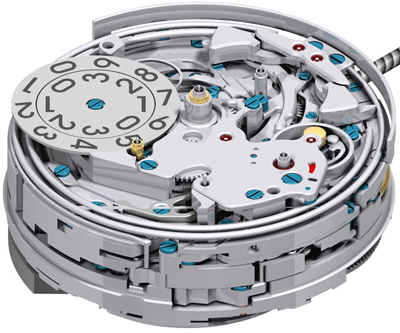 Despite the great number Despite the great number of functions and hands (I’ve counted 11 pieces), located on the dial, the time meter does not look too loaded, and the design is quite stylish and serious. The abovementioned triple power reserve indicator shows the energy reserve of movement (at "6" hours), alarm and minute repeater. Behind the alarm indicator there is a small aperture of repeater wind reserve indicator with a ball, changing its color from black (winding hasn’t run out) to red (winding is needed). Under the sapphire glass on the dial there are small second hand at "9" hours, central second hand of chronograph and 30-minute counter at "3" hours. The minute repeater is activated by pressing the button on the crown on the right side of the case, and the alarm setting with a hand from 18-carat pink gold is performed at the indicator between "7" and "8" hours with the lower button on the left side of the case, and the upper left button stops the alarm. The hand of pink gold on indicator at "9" hours shows the time of the second zone, for which the buttons on the left side of the case are responsible. The right button on each side of the crown traditionally control the chronograph. The apertures of big date are situated at "12 hours". Well, we only need to make out various buttons and remember, what function is fulfilled by each of them. of functions and hands (I’ve counted 11 pieces), located on the dial, the time meter does not look too loaded, and the design is quite stylish and serious. The abovementioned triple power reserve indicator shows the energy reserve of movement (at "6" hours), alarm and minute repeater. Behind the alarm indicator there is a small aperture of repeater wind reserve indicator with a ball, changing its color from black (winding hasn’t run out) to red (winding is needed). Under the sapphire glass on the dial there are small second hand at "9" hours, central second hand of chronograph and 30-minute counter at "3" hours. The minute repeater is activated by pressing the button on the crown on the right side of the case, and the alarm setting with a hand from 18-carat pink gold is performed at the indicator between "7" and "8" hours with the lower button on the left side of the case, and the upper left button stops the alarm. The hand of pink gold on indicator at "9" hours shows the time of the second zone, for which the buttons on the left side of the case are responsible. The right button on each side of the crown traditionally control the chronograph. The apertures of big date are situated at "12 hours". Well, we only need to make out various buttons and remember, what function is fulfilled by each of them.
The men's watch “Zenith Grande Class Traveller Repetition Minutes” has a case, made of precious rose gold, and a silver dial, and the company has produced a model with similar specifications, but of white gold with black dial. Among the merits of Zenith watchmakers there is also a high index of water resistance for repeater - 50 meters. The back case has a "viewing window" of sapphire glass. Each model comes with a black alligator leather strap with triple gold buckle. If we take into account the complexity of manufacturing this time meter, it becomes clear why Zenith cannot produce more than three models of such watches per year, so each owner of Zenith Grande Class Traveller Repetition Minutes might count on exclusivity of his time meter.
Returning to the "fruity" repeaters, I cannot help but note that the production of such musical complication is a prerogative of only the most talented watchmakers and most successful watch companies. If a model contains any of existing types of repeater, you may easily search other unique complications in it, and "laudatory odes" in honor of the company-creator of "speaking" time meter in recent news reports.
|


